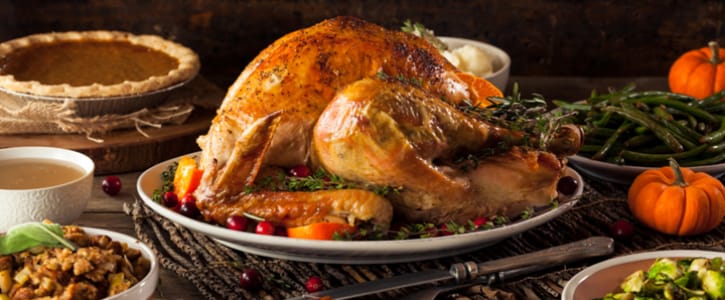November 12, 2024
Dr. Michael Swanson, Chief Agricultural Economist; Courtney Schmidt, Sector Manager; and Robin Wenzel, Group Head, Wells Fargo Agri-Food Institute

Although food inflation continues to slow, budgeting for Thanksgiving might be challenging for consumers still acclimating to historic food price increases. To help shoppers find the best value, Wells Fargo’s Agri-Food Institute compared the costs between store brands (private label) and national name brands for the typical Thanksgiving menu. Turns out, a store brand menu to feed 10 friends and family members yields a total savings of $17. This said, there are some surprise findings. In several categories, the name brand products are actually less expensive than the store brand, and in others, prices are almost the same. This gives shoppers the option to mix and match depending on tastes and brand loyalty.
The menu for 10 that we created includes turkey, stuffing, salad, cranberries, dinner rolls and pumpkin pie. Using name brand products, the meal will cost $90 this year, down 0.5% from last year’s Thanksgiving meal. The same meal prepared using store brands will cost $73, up 2.7% from last year. It is not surprising that shoppers can save money using store brand products, but it is surprising that the full meal cost using store brands is up from a year ago while the full meal cost using name brand products is down. How is this possible?
Since COVID turned the world upside down, consumers continue to watch for things to settle back to normal. Food inflation broke loose from its restraints, and many name brand food companies tried to establish the new normal, but seemingly, some of their price points were a bit too high. Within the grocery store, name brand and store brand food products dance a daily tango in an effort to find the perfect balance between preference and cost competitiveness.
So, let’s walk through the holiday menu and gain insight into brand name versus store brand product prices to determine the best move for price-conscious consumers.
Takes on turkey
Let’s start in the center of the table with the big bird. Fresh turkey prices are almost unchanged from a year ago – welcome news following several years of price fluctuation. Beyond the deli, most turkey gets sold in the couple of weeks just prior to Thanksgiving, making forecasting the final price of Thanksgiving an exercise in guessing price momentum. This year there is little movement. The industry has battled the highly pathogenic avian influenza (HPAI) which led to a loss of production against a dramatic fall in the cost of feeding the birds. Name brand turkeys, accounting for three of four birds sold, are realizing price softness with a 2% decline from 2023, but store brand, which is still cheaper, indicates a price increase of 5%. The total price difference between a 16-pound name brand bird and store brand bird is just a couple of dollars, so it’s unlikely that this small price differential for the holiday’s most valuable player will greatly shift the decision to store brand over name brand.
Stuffing that masterpiece
If the big turkey is the centerpiece of the table, stuffing is the essential sidekick. There are as many stuffing variations as there are families who enjoy them, so we narrowed in and looked at the category of prepared stuffing mixes to support the superstar. Just like the turkey, most boxed stuffing mix is sold at the same time as the bird, making it a super seasonal purchase. This category is still on the rise thanks to the trailing costs of labor and transportation. The name brand category is up 9% from the same period a year ago, and the store brand is up 3%. Consumers can save a couple dollars using the store brand. Honestly, it is a tough call with so much riding on a couple of dollars for one of the highlights of the table.
Salad thyme
Another centerpiece is the salad. Pre-packaged salad mixes have soared in popularity due to convenience and, here again, we see the category experiencing price reductions year-to-date compared to 2023. Similar to the turkey category, name brand products are giving up the most ground, with prices down 2%, and store brands down 1%. Not considered a seasonal category, the cost differential between the name brand and store brand is about $3 in favor of the store brand. It is likely that the cost-conscious consumer already chooses the store brand, since the market for this category is split 50/50 in terms of sales between the two.
Cranberry picks
Cranberries are a favorite for this fall feast with a very seasonal sales pattern similar to turkeys. Forecasting the final price at Thanksgiving involves gauging the price momentum and current harvest, expected to be 2% larger than in 2023. The name brand product owns the larger share of sales, and is surprisingly the lower-priced option. A 12-ounce bag of name brand fresh cranberries is down 3% from this time in 2023, while the same size bag of store brand cranberries is up 6%. It’s easy to understand why most consumers will choose the name brand product in this category.
Dinner roll kneads
The bakery category provides a key offering for the Thanksgiving celebration. Both name brand and store brand dinner rolls are up 3% from a year ago, placing the bakery section on the high end of the food inflation range. Bakery product prices have increased by a significant 28% since COVID, after a decade of almost no change. The price difference between name brand and store brand is significant for a couple of dozen dinner rolls, yielding almost $4 in savings between the labels, with store brand generating the most savings. Now the huge caveat – the quality differences between name brand products and store brand products can be very noticeable in some categories. So, a thorough review of taste preference is needed, as consumers might be trading quality for savings, making this category a very personal choice of cost to benefit.
Pumpkin pie-rates
At the end of it all, it’s pie time, requiring a bigger slice of the budget in 2024. Pumpkin pie is a seasonal dessert, making it a momentum forecasting category. Name brand pumpkin pies are up 1%, and the store brand are up 3% compared to a year ago. After all the price shuffling, the two are essentially the same price for an 8-inch pumpkin pie, making this a jump ball for the decision maker. If consumers prefer a brand name versus a store brand, it won’t hurt the budget. However, some name brands versus private labels can be big price exceptions, so consumers should keep their eyes open for opportunities like deals and discounts through smart research.
Beverage breakdown
Last of all, we looked at beverages. It is a vast, wild, and wooly category with beer and wine prices all over the place. Shoppers can break the bank or find a nice deal with careful research. The Bureau of Labor Statistics CPI index indicates that beer is up 3.3% from this time last year, while wine is up 2.4%. The soft drink category has a split personality with 12-ounce cans up 1.7% and two-liter bottles down a surprising 10.8% from this same time in 2023. So, take advantage of two-liter bottled soft drinks to help balance the budget.
In summary, cost-conscious shoppers who are not overly brand loyal have the best chance for realizing the biggest savings when shopping for this year’s Thanksgiving feast. Bottom line, there are good buys to be found with both name brand and store brand products if one takes the time to do comparison shopping.
 Michael Swanson, Ph.D. is the Chief Agricultural Economist within Wells Fargo's Agri-Food Institute. He is responsible for analyzing the impact of energy on agriculture and strategic analysis for key agricultural commodities and livestock sectors. His focus includes the systems analysis of consumer food demand and its linkage to agribusiness. Additionally, he helps develop credit and risk strategies for Wells Fargo’s customers, and performs macroeconomic and international analysis on agricultural production and agribusiness.
Michael Swanson, Ph.D. is the Chief Agricultural Economist within Wells Fargo's Agri-Food Institute. He is responsible for analyzing the impact of energy on agriculture and strategic analysis for key agricultural commodities and livestock sectors. His focus includes the systems analysis of consumer food demand and its linkage to agribusiness. Additionally, he helps develop credit and risk strategies for Wells Fargo’s customers, and performs macroeconomic and international analysis on agricultural production and agribusiness.
Michael joined Wells Fargo in 2000 as a senior economist. Prior, he worked for Land O’ Lakes and supervised a portion of the supply chain for dairy products, including scheduling the production, warehousing, and distribution of more than 400 million pounds of cheese annually, and also supervised sales forecasting. Before Land O’Lakes, Michael worked for Cargill’s Colombian subsidiary, Cargill Cafetera de Manizales S.A., with responsibility for grain imports and value-added sales to feed producers and flour millers. Michael started his career as a transportation analyst with Burlington Northern Railway.
Michael received undergraduate degrees in economics and business administration from the University of St. Thomas, and both his master’s and doctorate degrees in agricultural and applied economics from the University of Minnesota.
 Courtney Buerger Schmidt is a Sector Manager within Wells Fargo’s Agri-Food Institute focused on the protein, cotton, and hay sectors. Courtney originally joined Wells Fargo in 2014 as a relationship manager within The Private Bank Wealth Management group where she spent two years prior to assuming her current role. Before Wells Fargo, Courtney spent six years as a commodity broker and research analyst with Frontier Risk Management developing hedge and risk management strategies for Agribusiness clients, and also served as assistant director of the research division that focused on livestock, grain, and oilseed.
Courtney Buerger Schmidt is a Sector Manager within Wells Fargo’s Agri-Food Institute focused on the protein, cotton, and hay sectors. Courtney originally joined Wells Fargo in 2014 as a relationship manager within The Private Bank Wealth Management group where she spent two years prior to assuming her current role. Before Wells Fargo, Courtney spent six years as a commodity broker and research analyst with Frontier Risk Management developing hedge and risk management strategies for Agribusiness clients, and also served as assistant director of the research division that focused on livestock, grain, and oilseed.
Courtney holds a Bachelor of Science degree in Agricultural Economics with an emphasis in finance and real estate from Texas A&M University. Courtney was recently selected for Texas Agriculture Lifetime Leadership (TALL) Cohort XVIII 2022-2024. She is also a member of the Texas A&M College of Agriculture Development Council .
 Robin Wenzel is a senior vice president and the head of Wells Fargo’s Agri-Food Institute, a team of national industry advisors providing economic insights, analytics, research, and reporting across the agribusiness, food, and beverage spectrum. With more than 30 years of commercial and corporate banking experience, Robin leads with a strategic vision and an ability to expand and execute on the team’s deliverables to better support Food, Beverage, and Ag customers and prospects.
Robin Wenzel is a senior vice president and the head of Wells Fargo’s Agri-Food Institute, a team of national industry advisors providing economic insights, analytics, research, and reporting across the agribusiness, food, and beverage spectrum. With more than 30 years of commercial and corporate banking experience, Robin leads with a strategic vision and an ability to expand and execute on the team’s deliverables to better support Food, Beverage, and Ag customers and prospects.
Robin received her degree in Business from the University of San Francisco with an interest in Finance and International studies.
Robin has long been recognized for her work as a leading voice in the wine industry in Napa, CA. She is also a recipient of the 2017 North Bay Business Journal Women in Business Award.

 Sign On
Sign On 
 Michael Swanson, Ph.D. is the Chief Agricultural Economist within Wells Fargo's Agri-Food Institute. He is responsible for analyzing the impact of energy on agriculture and strategic analysis for key agricultural commodities and livestock sectors. His focus includes the systems analysis of consumer food demand and its linkage to agribusiness. Additionally, he helps develop credit and risk strategies for Wells Fargo’s customers, and performs macroeconomic and international analysis on agricultural production and agribusiness.
Michael Swanson, Ph.D. is the Chief Agricultural Economist within Wells Fargo's Agri-Food Institute. He is responsible for analyzing the impact of energy on agriculture and strategic analysis for key agricultural commodities and livestock sectors. His focus includes the systems analysis of consumer food demand and its linkage to agribusiness. Additionally, he helps develop credit and risk strategies for Wells Fargo’s customers, and performs macroeconomic and international analysis on agricultural production and agribusiness. Courtney Buerger Schmidt is a Sector Manager within Wells Fargo’s Agri-Food Institute focused on the protein, cotton, and hay sectors. Courtney originally joined Wells Fargo in 2014 as a relationship manager within The Private Bank Wealth Management group where she spent two years prior to assuming her current role. Before Wells Fargo, Courtney spent six years as a commodity broker and research analyst with Frontier Risk Management developing hedge and risk management strategies for Agribusiness clients, and also served as assistant director of the research division that focused on livestock, grain, and oilseed.
Courtney Buerger Schmidt is a Sector Manager within Wells Fargo’s Agri-Food Institute focused on the protein, cotton, and hay sectors. Courtney originally joined Wells Fargo in 2014 as a relationship manager within The Private Bank Wealth Management group where she spent two years prior to assuming her current role. Before Wells Fargo, Courtney spent six years as a commodity broker and research analyst with Frontier Risk Management developing hedge and risk management strategies for Agribusiness clients, and also served as assistant director of the research division that focused on livestock, grain, and oilseed. Robin Wenzel is a senior vice president and the head of Wells Fargo’s Agri-Food Institute, a team of national industry advisors providing economic insights, analytics, research, and reporting across the agribusiness, food, and beverage spectrum. With more than 30 years of commercial and corporate banking experience, Robin leads with a strategic vision and an ability to expand and execute on the team’s deliverables to better support Food, Beverage, and Ag customers and prospects.
Robin Wenzel is a senior vice president and the head of Wells Fargo’s Agri-Food Institute, a team of national industry advisors providing economic insights, analytics, research, and reporting across the agribusiness, food, and beverage spectrum. With more than 30 years of commercial and corporate banking experience, Robin leads with a strategic vision and an ability to expand and execute on the team’s deliverables to better support Food, Beverage, and Ag customers and prospects. 